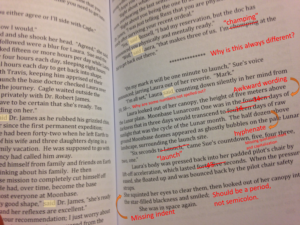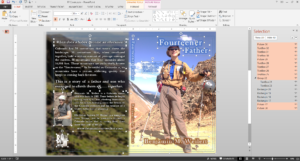I have always said that one of the main benefits of self-publishing is that there is no financial barrier to entry. Anyone can write a book and have it published without paying a cent to anyone. Granted, this is also the reason why many people look down on self-publishing. With the costs of self-publishing being non-existent, there are no quality checks to ensure the content being published is good enough for readers to spend their money to buy it. Sometimes, this can result in backlash with angry readers leaving negative reviews. Often, not investing in a written work doesn’t produce the sales an author would like to make (and is the main reason I don’t make a living with my writing).
Over the years, I’ve learned that self-publishing isn’t just writing a book. Instead, self-publishing is editing, formatting, cover design, marketing, and any number of other tasks that combine to create a polished product. Depending on an author’s skill level, some of these tasks can be accomplished for free—because the author does the tasks themselves. There are plenty of free tools available online that can help authors create professional products. Still, sometimes a little extra investment toward polishing a manuscript or commissioning an amazing cover can go a long way.
What tasks are worth the money?
Some elements of self-publishing are fairly inexpensive. For instance, I pay less than $20 a year for my website domain (www.benjamin-m-weilert.com) and $5 a month to host it. I’ve already covered why authors need an online presence, and a custom website is useful to have so you can direct potential readers to your books. I also have author friends who have had some luck paying for work through websites like Fiverr. They were able to get 3-D printed models made, logos designed, and other aesthetic elements created to help market their books. Of course, you can spend a lot on marketing, with targeted online ads on Facebook and Amazon, but I think these are purchases that should wait until the two main costs are covered. The way I see it, there are two categories of costs any self-published author should be ready to pay if they want to create a polished book: Editing and Cover Art.
 1. Editing
1. Editing
If there’s one place where money is well spent on a self-publishing project, it’s editing. Admittedly, this is where sticker shock can unnerve neophyte authors and cause them to avoid an editor altogether. I’ll admit that I don’t always pay for an editor. When I do, I want it to be for a book that I want to be taken seriously. Books like my memoir, Fourteener Father, and my hard sci-fi, Buried Colony, have both received professional edits, and I don’t think I’ll ever make money back on those costs. Even with the discount I had for these edits, it still came out to around $1 per 100 words. Obviously, you’ll want to shop around a little to find an editor that fits your style, but professional rates can add up fast. Of course, knowing if you need line edits, structural edits, or proofreading edits should help cut some of your costs as well.
Alternatively, if costs close to $1,000 are too high for you, there are alternatives out there that won’t break the bank. At a minimum, I’d try using Grammarly, which has a premium subscription that’s generally less than $200 a year. While Grammarly does a good job at pointing out some of the flaws in your writing, it is still only a program and won’t catch everything about your writing that needs to be fixed. This is one of the benefits of hiring an editor: they can identify the blind spots in your writing that can be difficult to spot when you’re just editing by yourself. Perhaps it’s how you structure your sentences or the way you use dialogue tags. Whatever it is, a professional editor should be able to work with you to improve your writing, which is why it’s worth the cost.
Another item I’d put under “editing” is hiring a sensitivity reader. While your free beta readers can give some insightful feedback into how your manuscript is received, they may lack the cultural background to help you iron out any objectionable material that may be harmful to people groups that you do not intimately understand. Stereotypes can easily infiltrate your writing and make potential readers uncomfortable with inaccurate character actions and descriptions that merely perpetuate the negative aspects of these communities. Again, you can shop around a bit for this, but expect to budget about $500 for this review, especially if you are trying to include diverse characters that do not match your background.
2. Cover Art
One of the biggest lies authors are told is that readers shouldn’t judge a book by its cover. In reality, most books have a fraction of a second to grab any potential reader’s attention. The first step in making a book attractive is in the cover art. The cover art should quickly convey two things about your book: what genre it is and what it’s about. The title can do a lot of heavy lifting here, but the imagery associated with it is what makes or breaks a sale. Something to consider when buying cover art is what rights you have to distribute said art. Usually, a good artist will have a contract that details the usage of the image you have bought. Sometimes, you can only use it for the cover. If you pay a little extra, you can obtain the rights to sell the image separately. While it’s tempting to peruse the internet and find the “perfect picture” for your cover, be sure you have the rights to use it! Visual artists want to be fairly compensated for their time, so expect a good cover art image to run anywhere from $120 to $1,000 (depending on factors like backgrounds, color, and scale).
When it comes to purchasing cover art, be sure you know the formats your book will take. If you only need an eBook cover, then there’s less to consider than if you’re publishing in paperback or hardcover format. However, if you’re not comfortable with the design aspects of creating covers, you may want to hire a graphic artist. A graphic artist can arrange the text over the cover art you purchased and make sure that everything is placed correctly so the barcode, spine, and other key measurements for your cover line up correctly. Additionally, they can help with interior formatting as well, choosing the right fonts, chapter header images, and scene break dingbats to create the right “feel” for your book. The cost for this service can be as low as $25 for an eBook or up to $100 for physical books.
As was the case for editing, there are cheaper alternatives. While I have used them myself, I would try and stay away from the free “cover creators” provided by Amazon or other publishing services. There isn’t a lot of freedom in these tools, and most of the covers created by these creators stand out as being particularly unprofessional. That being said, I have found Canva to be a fairly robust free alternative to the online cover creators provided by Amazon, even if it does have its limitations as well. At the very least, Canva’s selection has the feel of modern book covers that don’t feel like a cover creator made them. Still, Canva works best with eBook covers and other online marketing materials, and not so much on the full design for a paperback or hardcover book cover.
“Free” self-publishing can cost up to $2,600!
The costs I’ve detailed here are only to get your book into publishable shape. If you decide you want to sell physical copies of your book, you’ll have to factor in costs like printing author copies and shipping (both from the printer to you and from you to your customers). Ironically, many of the costs I’ve described above are covered by traditional publishers if you choose to go that route. This is perhaps the biggest downfall of self-publishing: the author has to cover these costs. Still, many authors (myself included) save money by performing some of these tasks themselves. For instance, I have a fairly good background in graphic design and have done all the interior formatting and cover design for my books. However, I am not as good at editing or cover art, so I make sure to pay a fair price to self-publish a polished product.
Can you tell if a self-published author didn’t have an editor?
Is it obvious when a self-published author uses a cover creator?
What elements of a book do you think are worth the money?
